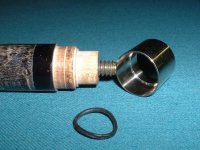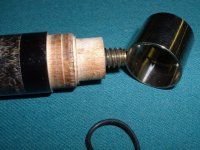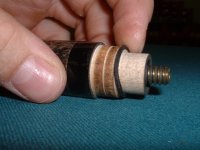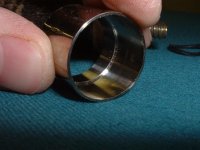You are using an out of date browser. It may not display this or other websites correctly.
You should upgrade or use an alternative browser.
You should upgrade or use an alternative browser.
I'll never understand cue makers...
- Thread starter ratcues
- Start date
tell the guy he should have bought a rat cue!
I could see that o-ring dampening the pingy sound many stainless joints made. Ray took extra time to do things in his joints to accomplish things he felt important. For instance he drilled all the way through his joint screw so he had no internal pressure when gluing in the joint pin. He made his shafts and butts all interchangeable. He was among the first to do that. He also was one of the first to use a thin wall shorter length stainless joint sleeve. I am not convinced what he did there was a bad idea.
Here is some things I think might help you understand cuemakers a little better.
We are inventors. We try new things. We try to figure out how to solve little minute problems with the tiniest parts of the way a cue hits. We are always looking for ways to improve on the way things have been done in the past. Unfortunately we are also at times quick to criticize the way other cuemakers do things. We are a hard headed group of people who love our craft and strive to improve it. We fail at times. We try things that don't work. But we try again and again, always believing we will make some minor improvement that will help make our cue play better. I trust that is exactly what Ray or his helpers were attempting with that joint.
RIP Ray!
Here is some things I think might help you understand cuemakers a little better.
We are inventors. We try new things. We try to figure out how to solve little minute problems with the tiniest parts of the way a cue hits. We are always looking for ways to improve on the way things have been done in the past. Unfortunately we are also at times quick to criticize the way other cuemakers do things. We are a hard headed group of people who love our craft and strive to improve it. We fail at times. We try things that don't work. But we try again and again, always believing we will make some minor improvement that will help make our cue play better. I trust that is exactly what Ray or his helpers were attempting with that joint.
RIP Ray!
so this guy's complaining about someone blowing out his O ring?
Unfortunately we are also at times quick to criticize the way other cuemakers do things.
No one is critizing anything here. Just wanted opinions. As a cue maker myself, I know that I do not know everything. I start threads like this as a learning tool, not just for me, but anyone else that wants knowledge or perspective.
Last edited:
> I've never seen exactly how it was installed,but was told that Bill McDaniel at least tried some kind of "shock absorber" in his steel jointed cues. This came from someone not named Tommy or Jess,but worked there at one time. Maybe it was a variation of this technique.
I have nothing negative to say,Ray Schuler sold a LOT of cues. Tommy D.
I have nothing negative to say,Ray Schuler sold a LOT of cues. Tommy D.
I start threads like this as a learning tool, not just for me, but anyone else that wants knowledge or perspective.
Thank you!!!!!!!!!!
Ratcues - is that pin broken? Or is that the intended length?
Just wondering.
Gary
The pins are short and the pilot on the shaft is long.
Also, I cut the larger diameter piece of wood away so when you look at this, notice that you only see the smaller diameter piece and the O-ring groove.
Joint
Thanks for sharing. It's good to see different designs. I've been surprised a time or two by a cues innards. Thanks...
Thanks for sharing. It's good to see different designs. I've been surprised a time or two by a cues innards. Thanks...
I start threads like this as a learning tool, not just for me, but anyone else that wants knowledge or perspective.
And much appreciated as well Ryan.
I could see that o-ring dampening the pingy sound many stainless joints made. Ray took extra time to do things in his joints to accomplish things he felt important. For instance he drilled all the way through his joint screw so he had no internal pressure when gluing in the joint pin. He made his shafts and butts all interchangeable. He was among the first to do that. He also was one of the first to use a thin wall shorter length stainless joint sleeve. I am not convinced what he did there was a bad idea.
Here is some things I think might help you understand cuemakers a little better.
We are inventors. We try new things. We try to figure out how to solve little minute problems with the tiniest parts of the way a cue hits. We are always looking for ways to improve on the way things have been done in the past. Unfortunately we are also at times quick to criticize the way other cuemakers do things. We are a hard headed group of people who love our craft and strive to improve it. We fail at times. We try things that don't work. But we try again and again, always believing we will make some minor improvement that will help make our cue play better. I trust that is exactly what Ray or his helpers were attempting with that joint.
RIP Ray!
That's the story
Mario
CUE-TOOLS.COM
We are CUE-TOOLS.COM
There must be something magical about that joint. I do most of the cue repair for the 3 cushion players in my area and they all love Schuler cues. I have never seen one fail. He also used a unique weight system that had washers and rubber "O" rings that as you tighten the screw holding everything together the "O" rings would compress and expand and hold the weight in the butt of the cue without rattling. I was never much of a fan of his designs...but you can't argue about how his 3C cues perform.
There must be something magical about that joint. I do most of the cue repair for the 3 cushion players in my area and they all love Schuler cues. I have never seen one fail. He also used a unique weight system that had washers and rubber "O" rings that as you tighten the screw holding everything together the "O" rings would compress and expand and hold the weight in the butt of the cue without rattling. I was never much of a fan of his designs...but you can't argue about how his 3C cues perform.
That seems to be a pretty neat idea considering the fact that when the wood expands/compresses - the o-ring is there to maintain the tolerance needed for a tight fit.
Hi,That seems to be a pretty neat idea considering the fact that when the wood expands/compresses - the o-ring is there to maintain the tolerance needed for a tight fit.
Ray was a chemical engineer by degree. And he had that kind of mind that thought as an engineer. Just look at his system for the weight and bumper set up. When someone brings me a Schuler Cue with a bumper and weight bolt problem, I say go back to the OEM. I don't want to stock a bunch of washers, o-rings and nuts & bolts to do a job for penneys.
Some engineers tend to over engineer. Hoover and Jimmy Carter where also engineers and look what that got us!!
I for one do not like the look of a metal joint on a cue and now that guys are talking about sounds coming from them when you hit the ball, forgetaboutit!! I know there are some that are old school and like the look and that's ok. I just don't like them......:barf:
Don't get me wrong Ray Schuler was a good guy and great cue maker and his billiards cues are respected all over the world. I am a 3 cushion player and I play with his cue.
Rick G



